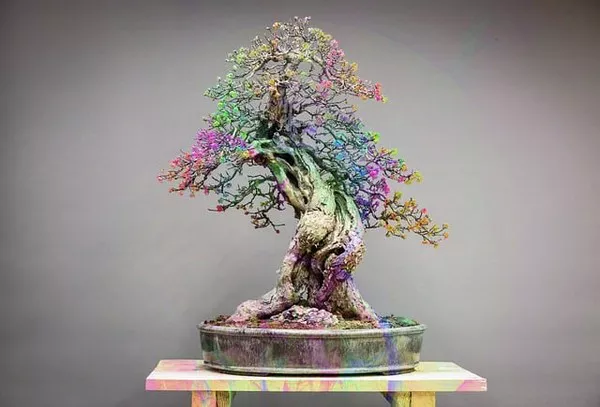Bonsai, the ancient Japanese art form of cultivating miniature trees in pots, has captivated enthusiasts for centuries. The allure of creating living sculptures that mimic the grandeur of nature on a diminutive scale has led to a diverse array of plant species being used for bonsai. While nearly any tree or shrub can potentially be transformed into a bonsai, selecting the right plant is crucial for success. In this comprehensive guide, we delve into the world of bonsai plants, exploring the characteristics, care requirements, and suitability of various species for bonsai cultivation.
Understanding Plant Selection for Bonsai
Choosing the appropriate plant species is the foundation of successful bonsai cultivation. Several factors must be considered to ensure compatibility with the bonsai aesthetic and the grower’s skill level. These factors include:
1. Size: Bonsai trees are miniature replicas of full-sized trees, so it’s essential to select species that naturally exhibit small leaves, flowers, and overall proportions.
2. Hardiness: Opting for plant species that are adaptable to bonsai techniques and can thrive in the grower’s climate is essential for long-term success.
3. Aesthetic Qualities: The ideal bonsai plant should possess attractive features such as interesting bark texture, graceful branching patterns, and seasonal changes in foliage or flowers.
4. Cultural Requirements: Understanding the specific cultural needs of each plant species, including sunlight, water, soil, and temperature requirements, is vital for providing proper care.
Popular Plant Species for Bonsai Cultivation
While the list of suitable plants for bonsai is extensive, several species are particularly well-suited for this art form. Let’s explore some of the most popular choices:
Japanese Maple (Acer palmatum):
Renowned for its delicate foliage and graceful form, the Japanese Maple is a favorite among bonsai enthusiasts. Its small leaves, vibrant autumn colors, and ability to develop intricate branch structures make it an excellent candidate for bonsai.
Chinese Elm (Ulmus parvifolia):
Highly adaptable and forgiving, the Chinese Elm is an ideal choice for beginners. It features small, glossy leaves and responds well to pruning and wiring, allowing for the creation of diverse bonsai styles.
Juniper (Juniperus spp.):
With its rugged, weathered appearance and ability to thrive in various climates, Juniper species are popular for creating classic bonsai styles such as cascade and windswept. They are also well-suited for shaping using Jin and Shari techniques to mimic aged, weather-beaten trees.
Ficus (Ficus spp.):
Ficus trees, including the Ficus benjamina and Ficus microcarpa, are favored for their resilience and suitability for indoor bonsai cultivation. They feature glossy leaves and are tolerant of low light conditions, making them ideal for bonsai enthusiasts living in apartments or regions with harsh winters.
Pine (Pinus spp.):
Pine species such as the Japanese Black Pine (Pinus thunbergii) and Scots Pine (Pinus sylvestris) are prized for their rugged beauty and ability to evoke a sense of maturity and strength in bonsai compositions. They require careful attention to wiring and pruning to achieve the desired aesthetic.
Trident Maple (Acer buergerianum):
Known for its distinctive three-lobed leaves and graceful branching, the Trident Maple is a versatile species suitable for various bonsai styles. It exhibits excellent fall coloration and is relatively forgiving of beginner mistakes.
Boxwood (Buxus spp.):
Boxwood species, such as Buxus microphylla and Buxus sempervirens, are valued for their fine foliage and compact growth habits, making them ideal for creating formal upright or informal bonsai styles. They respond well to frequent pruning and shaping.
Azalea (Rhododendron spp.):
Prized for their vibrant spring blooms and petite foliage, Azalea species are favored for creating bonsai with seasonal interest. They require specific care to maintain their health and encourage prolific flowering.
Special Considerations and Techniques
In addition to selecting suitable plant species, successful bonsai cultivation requires attention to specialized techniques:
1. Pruning and Trimming: Regular pruning and trimming are essential for maintaining the desired shape and proportions of bonsai trees. This includes removing unwanted branches, shaping foliage pads, and promoting ramification.
2. Wiring: Wiring is a fundamental technique in bonsai that allows growers to manipulate the shape and position of branches. Careful wiring can create movement and visual interest in bonsai compositions while maintaining a natural appearance.
3. Repotting: Bonsai trees require periodic repotting to refresh the soil, prevent root-bound conditions, and promote healthy growth. Repotting should be done during the tree’s dormant season to minimize stress.
4. Soil and Watering: Using well-draining bonsai soil is crucial for preventing waterlogged roots and ensuring proper aeration. Watering should be done judiciously to maintain consistent moisture levels without causing waterlogging or drought stress.
5. Styling: Bonsai styling involves shaping the tree’s branches and foliage to create a harmonious composition that reflects the desired aesthetic. This may involve selecting a specific bonsai style, such as formal upright, informal upright, cascade, or semi-cascade, and applying techniques to enhance the tree’s natural beauty.
Conclusion
Selecting the right plant species is a critical first step in the journey of bonsai cultivation. By understanding the characteristics, care requirements, and suitability of various plant species for bonsai, enthusiasts can create miniature masterpieces that embody the beauty and tranquility of nature in a compact form. Whether you’re drawn to the delicate foliage of a Japanese Maple or the rugged elegance of a Juniper, there’s a bonsai plant waiting to be sculpted into a living work of art. With patience, skill, and dedication, anyone can experience the timeless beauty of bonsai cultivation.


